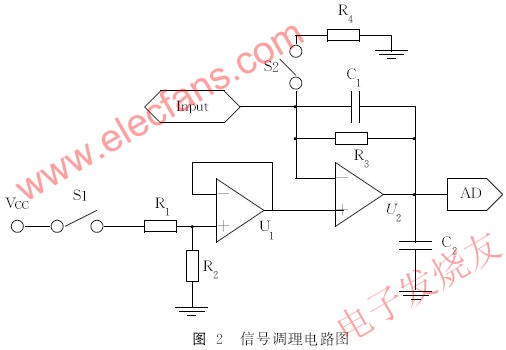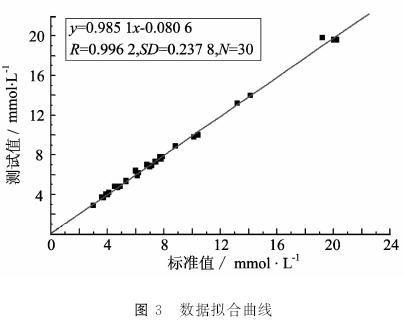0 Preface
Diabetes is a common metabolic endocrine disease, which is caused by the lack of insulin or abnormal receptors in the human body. It is characterized by high blood sugar and is a popular disease worldwide. In recent years, its incidence has shown a significant upward trend, and currently about 10% of adults worldwide suffer from this disease [1]. In China, there are about 40 million diabetic patients. The current treatment is mainly to regulate the glucose metabolism in patients. The important basis for clinical treatment administration is the blood glucose content of patients. Therefore, it is important to track and evaluate the control of diabetes through self-monitoring blood glucose meters. In particular, the self-monitoring blood glucose meter can easily and quickly detect the results in hospitals or even homes. At present, the market blood glucose meter products can only give blood glucose values. It is still difficult for patients to adjust the treatment plan and diet control accordingly. In addition, the test accuracy and test range are insufficient. Therefore, it is of great significance to study high-precision and intelligent blood glucose monitoring instruments.
1 Detection principle
The large-scale detection instruments used in clinical diagnosis are not suitable for small and medium-sized hospitals, emergency departments, and patients for long-term self-monitoring of the disease due to their large size, high price, and cumbersome detection process. The practical application of enzyme electrodes in biosensors has made rapid progress Enzyme electrodes for glucose, lactic acid, cholesterol, urea, amino acids are being widely used in medical testing. A common feature of these sensors is to use the molecular recognition capabilities of biological materials such as microorganisms, enzymes, antibodies, and sensors that use biological materials as molecular recognition elements; and then use the electrons generated by the reaction of the detected substance and enzyme contained in the sample solution to To reduce the electron acceptor, the measuring device uses an electrochemical method, that is, measures the amount of reduction of the electron acceptor, and performs quantitative analysis of the detected substance.
The detection principle of this instrument is based on glucose oxidase (GOD) solidified on the surface of the electrode. When blood drops into the blood glucose test electrode, an oxidation-reduction reaction occurs. During the reaction, the ferrous iron ions in the transmission medium lose electrons and occur. After the oxidation reaction, glucose oxidase oxidizes glucose to produce H2O2 and gluconic acid. H2O2 oxidizes the ferrous iron ions. During the redox process, electron gains and losses occur. Under a certain voltage, an oxidation current is formed. By detecting that the change in current is approximately linear with the glucose concentration, the purpose of detecting the blood glucose concentration is achieved. The specific reaction equation is as follows:

2 Instrument design and implementation
2.1 Hardware structure
The whole instrument system is composed of enzyme electrode sensing part, signal conditioning (current voltage conversion, amplifying and filtering part), temperature compensation part, liquid crystal display part, single chip microcomputer and intelligent chip, as shown in Figure 1. The micro current generated by the blood drop after the enzyme electrode is small and can only reach the level of micro amperes, which is not convenient for measurement and analysis, so it is first converted into a voltage signal, and then the voltage is amplified. Since the system noise generated by the interference signal from the power supply and various factors affects the test accuracy, the filter circuit should be designed to remove the interference signal to make the test more accurate. The processed voltage value is transmitted to the MSP430 with built-in A / D conversion, and the single-chip computer calculates the blood glucose concentration value, and then displays the result using the liquid crystal.

2.2 Main test process
The signal conditioning circuit in the detection system is shown in Figure 2. After the instrument is powered on, the single-chip microcomputer controls the multi-way switch S1 to close, and the input of the pre-stage op amp is the voltage division value of R1 and R2, which is set to 0.4V. According to the characteristics of the follower and the ideal op amp, the output of the subsequent stage will not change to 0.4V at this time. After A / D conversion, it is input to the single chip microcomputer, and the control display shows "please insert a test strip". When the system inserts a blood glucose test strip, S2 is closed and R4 is introduced into the circuit. The post-stage op amp constitutes an in-phase amplifier. Adjust R4 to make the circuit output value 0.6V. After A / D conversion, it is input into the single chip microcomputer, and the display screen is controlled to display "please drop blood". The current signal generated after blood dripping is input from "Input", the output voltage signal is abruptly changed and input to the single-chip microcomputer, and after the reaction is completed, the blood glucose value is calculated and displayed according to the voltage change.

2.3 Temperature compensation
Changes in ambient temperature cause changes in the zero drift and sensitivity of the detection system and cause measurement errors. In order to eliminate the influence of the ambient temperature, the temperature compensation circuit in the system is realized by the single bus miniature temperature sensor DS18B20 of DALLAS Company. Its temperature measurement range is -55 ~ + 125 ℃, the measurement resolution is 0.0625 ℃, and the temperature measurement accuracy is ± 0.5 ℃ . The temperature signal is input to the single-chip microcomputer through the multi-way switch, and the CPU automatically corrects the error of the test result according to the temperature characteristic of the blood glucose test electrode.
2.4 Smart Chip
In order to further improve the practicality of the instrument and to facilitate the patient as much as possible, the principle of artificial intelligence is introduced into the instrument, and the patient can obtain personal disease information and display simple treatment methods and precautions while detecting their blood glucose concentration. This function is mainly achieved by calling the information in the solidified smart chip with diabetes knowledge base. The knowledge base solidified in the chip is based on the treatment guidelines approved and published by the World Health Organization, the International Diabetes Federation and the Chinese Diabetes Association. The guidelines are authoritative in diabetes analysis. After measuring the blood glucose value, the patient can select the "inference" function on the operation interface.
3 Instrument performance analysis and testing
3.1 Easy operation and low power consumption
The patient only needs to follow the prompts to complete the whole test process after booting, and the operation interface is simple and friendly. According to the output voltage of the test conditioning as shown in Figure 2, it can be seen that the reaction tends to be stable around 20s after the blood is dripped, and the test time of the patient under the correct operation step does not exceed 25s. Because the siphon test paper is used for blood collection, only 3 to 5 μL is required for a single blood collection. Select MSP430 series low power consumption single chip microcomputer, the instrument can automatically cut off the power after taking out the test paper according to the voltage change during the test, which can effectively save energy consumption.
3.2 Wide test range
According to the diagnostic criteria for non-insulin-dependent diabetes mellitus (NIDDW) recommended by the WTO in 1998, blood glucose of less than 7 mmol / L is non-diabetic (fasting blood glucose of 3.5 to 7 mmol / L is the normal range), and 7 to 11.1 mmol / L For impaired glucose tolerance, greater than 11.1mmol / L is diabetic. After testing with different samples, the test range of this instrument can reach 2.2 to 27.8 mmol / L, which completely covers the range of possible values ​​of human blood glucose.
3.3 Reliable test data
In order to verify the true reliability of the measurement data of the blood glucose detector, a clinical test was conducted in the research room of the First Hospital of Shanxi University. Respectively test samples with different blood glucose concentrations with an intelligent blood glucose meter and a large Italian biochemical analyzer (BT? 3000). The test results show that the two have a good consistency. The error at high blood glucose is greater than that at low and normal blood glucose, which requires further calibration and calibration. The test values ​​of large-scale biochemical analysis are used as standard values, and the test results of 30 groups are shown in Table 1. Perform regression analysis on the test data, and the fitting results are shown in Figure 3. The regression equation is
In the formula: regression coefficient b = 0.9851, intercept a = -0.0806, correlation coefficient R = 0.996, standard deviation SD = 0.2378.

Table 1 Comparison results of smart blood glucose meter and standard blood glucose value

4 Conclusion
The blood glucose concentration measured by the intelligent blood glucose self-monitor has a significant correlation with the measurement result of the high-precision blood glucose meter, and has the advantages of simple operation, short measurement time, more accurate and reliable results, high intelligence, and low power consumption. The improvement can be an ideal instrument for diabetic patients to monitor and control their own blood glucose concentration at home.
Acknowledgements: Thanks to the Taiyuan Science and Technology Bureau and North University for providing fund support for this project; the medical staff of Shanxi University First Hospital for their assistance and providing experimental equipment and venues. Thanks to the technical guidance given by Professor Zhou Hanchang and the technical support given by Beijing Soft Test Company on artificial intelligence chip technology.
· Backup Camera Blind Spot Camera When Parking Backing Reversing Your Trailer to Get Decent Image Quality to Make Your Reversing More Confident and Safety.
· Rear View Backup Camera and Monitor Kit : Waterproof Camera With Infrared Lights and HD Sensor & Night Vision.
· Reverse Backup Car Dash Security Sensor Camera For Trucks RV , Will Offer Much Safety Drive With It ,Extra Eyes on Trucks Behind and Side.
·
Quad Backup Camera Monitor System
Backup Camera Monitor,Quad Backup Camera Monitor System,Quad Split Monitor,Wired Quad View Monitor
Shenzhen Sunveytech Co.,LTD , https://www.sunveytech.com